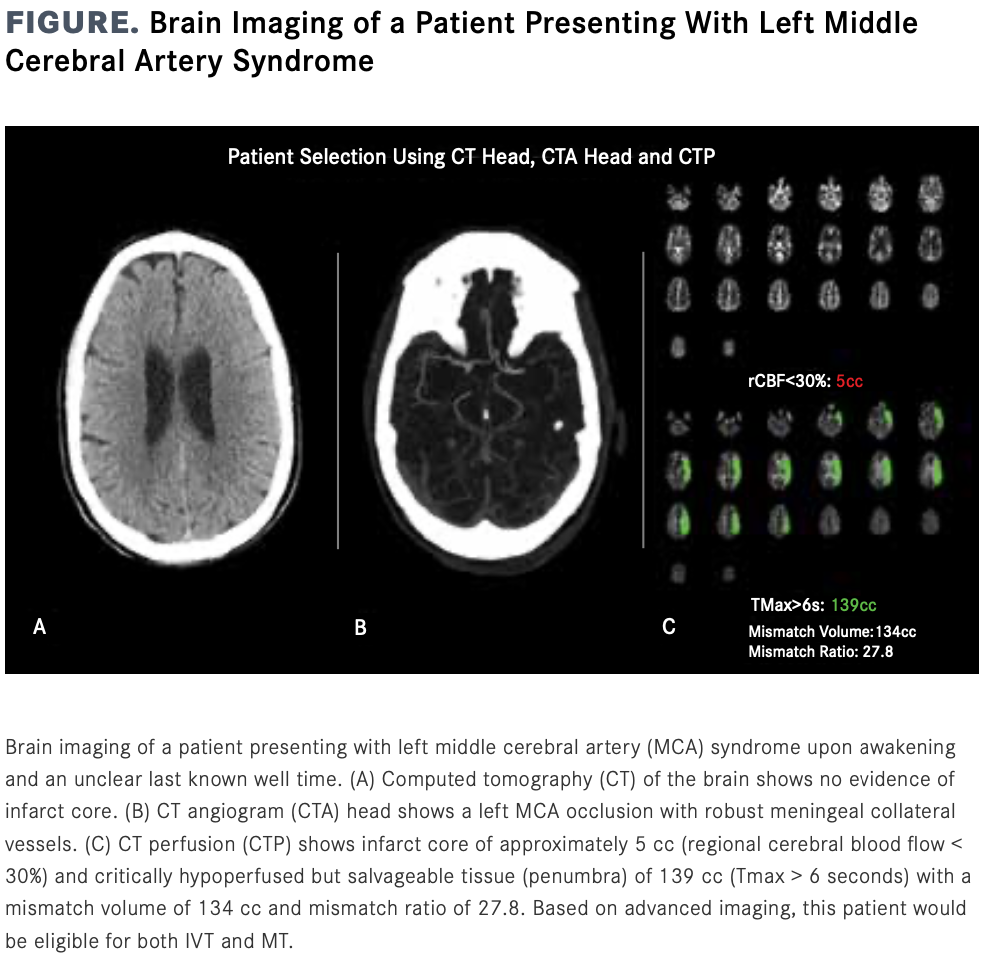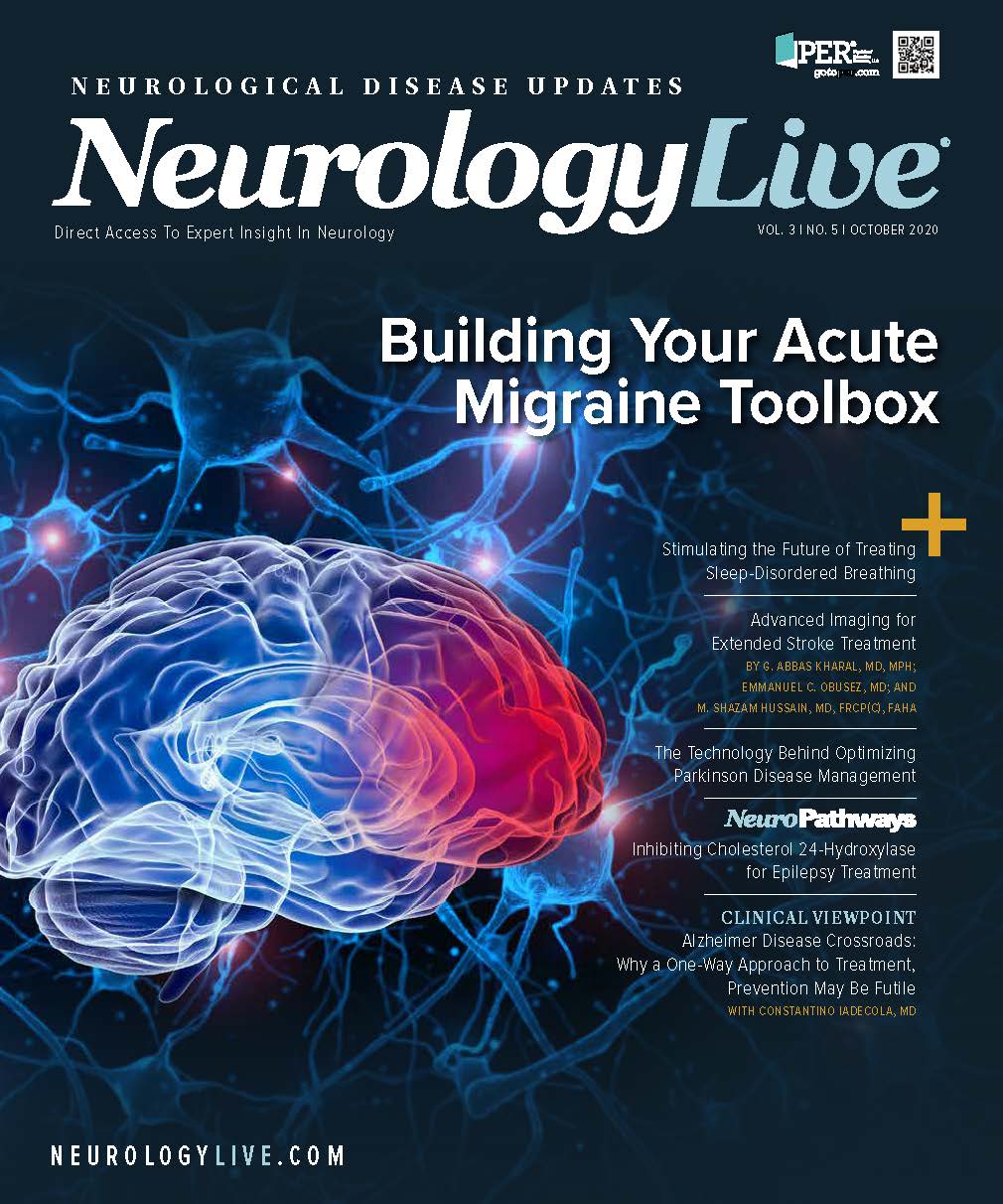Publication
Article
NeurologyLive
Advanced Imaging for Extended Stroke Treatment
Author(s):
With many patients presenting with an unknown time of last known well, establishing a tissue window using advanced imaging techniques may allow for more effective intervention and better outcomes.
G. Abbas Kharal, MD, MPH

Advanced brain imaging has allowed for cutting-edge stroke interventions to be extended to patients with ischemic stroke beyond conventional time windows and has revolutionized stroke care worldwide.1-4 Diffusion-weighted magnetic reso- nance imaging (MRI) and computed tomography perfusion (CTP) imaging have gained widespread use as diagnostic tools that aid
in decision-making for reperfusion therapies. Clinicians have used both CTP and MRI in an emergent setting to help better predict the time of onset of ischemic event, calculate infarct core, and estimate potentially salvageable brain tissue.1,5 Such advanced imaging has allowed for extending intravenous thrombolysis (IV-T) windows for patients presenting up to 9 hours from last known well (LKW) and mechanical thrombectomy (MT) windows for patients with emergent large vessel occlusion (ELVO) up to 24 hours from LKW time.6
Advanced imaging in extending intravenous thrombolysis window
Although the time window to give IV-T is within 4.5 hours from LKW, approximately 14% to 27% of patients with ischemic stroke wake up with stroke symptoms and have an unclear time of symptom onset.2,7 Most patients with wake-up strokes are believed to have likely had the initial stroke event within a few hours of awakening.7 In such patients, the LKW time may not be an accurate marker of symptom onset and, therefore, the use of a tissue window rather than a time window is needed. Clinicians have used both CTP and MRI to help better predict the time of onset of ischemic event and calculate infarct core and potentially salvageable brain tissue.5,8 In the case of MRI, they have used the mismatch between diffusion-weighted imaging (DWI) and fluid-attenuated inversion recovery (FLAIR) imaging as a surrogate for time of onset that seems to correlate with symptom onset within 4.5 hours.8 In contrast to MRI, CTP visualizes brain infarction indirectly based on perfusion changes. Decreased cerebral blood flow (CBF), in other words, CBF that is less than 30% relative to normal brain tissue (regional CBF [rCBF]), has been validated as a marker of ischemic core3 (FIGURE).

The above concept has served as the basis for clinical trials that aimed to extend thrombolysis windows based on tissue windows rather than time windows in patients with wake-up strokes. The WAKE-UP trial (NCT01525290), concerning MRI-guided thrombolysis for stroke with unknown time of onset, investigated whether patients with acute ischemic stroke who were LKW more than 4.5 hours and who had a DWI/FLAIR mismatch on MRI brain scan were more likely to have a good outcome at 90 days with alteplase compared with placebo.9 Treatment with IV alteplase resulted in a significantly better functional outcome (53.3% vs 41.8%) than placebo at 90 days when using a mismatch between DWI and FLAIR as a criterion for treatment.
In the EXTEND trial (NCT01580839), investigators used perfusion-based imaging to determine if IV thrombolysis with alteplase initiated between 4.5 and 9.0 hours after stroke onset or upon awak- ening with stroke symptoms improved outcomes in patients who had hypoperfused but salvageable brain tissue.2,4 Of the 225 patients enrolled, 65% had stroke symptoms upon awakening. The investigators used CTP or perfusion-diffusion MRI scans to assess infarct core and perfusion deficit using Rapid Processing of Perfusion and Diffusion (RAPID) automated software (iSchemaView). Perfusion lesion to infarct core mismatch was defined as a ratio greater than 1.2 between the volume of hypoperfused but salvageable tissue and the volume of the infarct core, an absolute difference in volume greater than 10 mL, and an infarct core volume of 70 mL or less. Using perfusion imaging to allow IV-T with alteplase within 4.5 to 9.0 hours from LKW or upon awakening resulted in a higher percentage of patients with functional independence than those treated with placebo.
Moreover, with better recanalization rates and functional outcomes seen with tenecteplase versus alteplase within 4.5 hours in the EXTEND-IA TNK trial (NCT02388061),10 an additional question is whether tenecteplase might be a better thrombolytic choice than alteplase for patients presenting in the extended window of 4.5 to 9.0 hours from time LKW. The ongoing TWIST (NCT03181360) study from Norway aims to answer this question. Moreover, the ongoing TIMELESS study (NCT03785678) in North America is a phase 3, randomized, placebo-controlled trial of IV-T in patients presenting within 4.5 and 24 hours from time LKW with ELVO, using perfusion-based imaging to assess the efficacy and safety of tenecteplase.
Advanced imaging in extending mechanical thrombectomy window
Several randomized clinical trials showed significant improvement in functional outcomes at 90 days with MT for patients with ELVO ischemic stroke within the early window of 6 hours from time LKW.11 However, with the use of MRI and CTP for patient selection, data from the DAWN (NCT02142283)12 and DEFUSE 3 (NCT02586415)13 studies have allowed for expansion of the treatment window for MT to 24 hours from time LKW. Therefore, a significantly larger number of patients are now eligible for MT with the use of advanced imaging for patient selection.
For patients with anterior circulation ELVO ischemic stroke, DEFUSE 3 enrolled participants within 6 to 16 hours from LKW whereas DAWN enrolled participants within 6 to 24 hours from LKW. Patient selection in both trials required advanced imaging using either CTP or MRI, with the majority of patients being selected by CTP.1 Investigators measured ischemic core and penumbral tissue volumes using RAPID software with relative CBF less than 30% for CTP, and RAPID DWI lesion volume with an apparent diffusion coefficient (ADC) threshold of less than 620 × 10−3 mm/s for MRI. They calculated the volume of penumbral or salvageable tissue using the Tmax threshold of more than 6 seconds on both CTP and MR perfusion imaging. Subtracting the infarcted core volume from the penumbral volume provided the mismatch volume, whereas dividing the penumbral volume by the infarcted core volume provided the mismatch ratio.8 In DEFUSE 3, patients were included if they had a mismatch volume greater than 15 mL and a mismatch ratio of 1.8 or greater.13 The DAWN trial had a more strict inclusion criteria where infarct core volume eligibility was further stratified by age and stroke severity.1,12 The penumbra in DAWN was inferred clinically. Both trials showed a significant benefit in functional outcomes at 90 days favoring MT in eligible patients with ELVO with salvageable tissue identified by advanced imaging.
Pitfalls of perfusion imaging
Although perfusion-based imaging has revolutionized the decision-making eligibility paradigm for treating patients with acute ischemic stroke, it is equally important to understand that no imaging modality is perfect. Therefore, stroke providers must be aware of the limitations and pitfalls of perfusion imaging. Firstly, no perfusion parameter or threshold perfectly describes the perfu- sion deficit but rather reflects the probability of infarction if reperfusion is not achieved and is only a single snapshot in time. Moreover, the speed at which the critically hypoperfused region will progress to infarction is heavily dependent on the status of collateral circulation; therefore, assessing collateral vessels in decision-making is equally important. Notably, a late increase in CBF can be seen in irreversibly damaged infarcted tissue in patients with spontaneous recanalization or those with persistent vascular occlusion if perfusion improves through robust collaterals.8,14 This ischemic tissue may be readily visible on noncontrast CT but will not be identified as ischemic core on CTP if the blood flow exceeds the threshold for infarct core detection. Therefore, comparing noncontrast CT images for established infarction with CBF and perfusion maps with Tmax greater than 6 seconds is necessary. The Alberta Stroke Program Early CT Score (ASPECTS) is a good estimator of established infarct core and clinicians should compare it with CBF maps for better accuracy in estimating infarct core size.15
Similarly, on MRI, the ADC changes with time and reperfusion state. A single ADC threshold may thus result in a different tissue fate depending on time from symptom onset and time to reperfusion as it is only a snapshot in time. Additionally, clinicians can use relative cerebral blood volume as a marker to assess the degree of collateral circulation and it is also a predictor of infarct growth.8
Conclusions
Given the high degree of variability in progression of infarction in individual patients, focusing on salvageable tissue rather than strict time parameters will allow clinicians to identify more patients who can benefit from stroke interventions. Advanced imaging can be a useful tool for patient selection in the late window; however, to use it most effectively in decision-making it is important to understand the limitations of these techniques, particularly when one can over-estimate core infarction and underestimate penumbral tissue, as this can prevent a patient from receiving an intervention when they may actually benefit.
Moreover, in addition to the duration and severity of hypoperfusion, the degree of collateral circulation contributes to the size of the infarct core, as robust collaterals may allow for a time-limited preservation of infarct core volume in ELVO. An assessment of collateral circulation with advanced imaging may help clinicians determine patients with potential slow versus rapid expansion of the ischemic core, which could further help with patient selection and decision-making.
References
1. Albers GW. Use of imaging to select patients for late window endovascular therapy. Stroke. 2018;49(9):2256-2260. doi:10.1161/STROKEAHA.118.021011
2. Campbell BCV, Ma H, Ringleb PA, et al; EXTEND, ECASS-4, and EPITHET Investigators. Extending thrombolysis to 4.5-9 h and wake-up stroke using perfusion imaging: a systematic review and meta-analysis of individual patient data. Lancet. 2019;394(10193):139-147. doi:10.1016/S0140-6736(19)31053-0
3. Thomalla G, Simonsen CZ, Boutitie F, et al; WAKE-UP Investigators. MRI-guided thrombolysis for stroke with unknown time of onset. N Engl J Med. 2018. 379(7):611-622. doi:10.1056/NEJMoa1804355
4. Ma H, Campbell BCV, Parsons MW, et al; EXTEND Investigators. Thrombolysis guided by perfusion imaging up to 9 hours after onset of stroke. N Engl J Med. 2019;380(19):1795-1803. doi:10.1056/NEJMoa1813046
5. Albers GW, Goyal M, Jahan R, et al. Ischemic core and hypoperfusion volumes predict infarct size in SWIFT PRIME. Ann Neurol. 2016;79(1):76-89. doi:10.1002/ana.24543
6. Davis SM, Donnan GA, Parsons MW, et al; EPITHET Investigators. Effects of alteplase beyond 3 h after stroke in the Echoplanar Imaging Thrombolytic Evaluation Trial (EPITHET): a placebo-controlled randomised trial. Lancet Neurol. 2008;7(4):299-309. doi:10.1016/S1474-4422(08)70044-9
7. Mackey J, Kleindorfer D, Sucharew H, et al. Population-based study of wake-up strokes. Neurology. 2011;76(19):1662-1667. doi:10.1212/WNL.0b013e318219fb30
8. Demeestere J, Wouters A, Christensen S, Lemmens R, Lansberg MG. Review of perfusion imaging in acute ischemic stroke: from time to tissue. Stroke. 2020;51(3):1017-1024. doi:10.1161/STROKEAHA.119.028337
9. Thomalla G, Simonsen CZ, Boutitie F, et al; WAKE-UP Investigators. MRI-guided thrombolysis for stroke with unknown time of onset. N Engl J Med. 2018;379(7):611-622. doi:10.1056/NEJMoa1804355
10. Campbell BCV, Mitchell PJ, Churilov L, et al; EXTEND-IA TNK Investigators. Tenecteplase versus alteplase before thrombectomy for ischemic stroke. N Engl J Med. 2018;378(17):1573-1582. doi:10.1056/NEJMoa1716405
11. Goyal M, Menon BK, van Zwam WH, et al; HERMES Investigators. Endovascular thrombectomy after large-vessel ischaemic stroke: a meta-analysis of individual patient data from five randomised trials. Lancet. 2016;387(10029):1723-1731. doi:10.1016/S0140-6736(16)00163-X
12. Nogueira RG, Jadhav AP, Haussen DC, et al; DAWN Trial Investigators. Thrombectomy 6 to 24 hours after stroke with a mismatch between deficit and infarct. N Engl J Med. 2018;378(1):11-21. doi:10.1056/NEJMoa1706442
13. Albers GW, Marks MP, Kemp S, et al; DEFUSE 3 Investigators. Thrombectomy for stroke at 6 to 16 hours with selection by perfusion imaging. N Engl J Med. 2018;378(8):708-718. doi:10.1056/NEJMoa171397314. Bang OY, Goyal M, Liebeskind DS. Collateral circulation in ischemic stroke: assessment tools and therapeutic strategies. Stroke. 2015;46(11):3302-3309. doi:10.1161/STROKEAHA.115.010508
15. Mokin M, Primiani CT, Siddiqui AH, Turk AS. ASPECTS (Alberta Stroke Program Early CT Score) measurement using Hounsfield unit values when selecting patients for stroke thrombectomy. Stroke. 2017;48(6):1574-1579. doi:10.1161/STROKEAHA.117.016745





